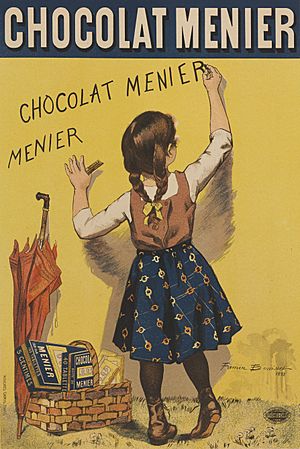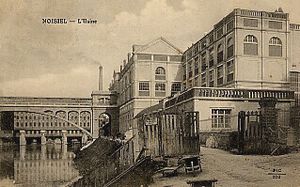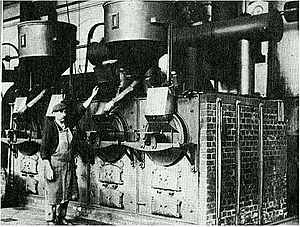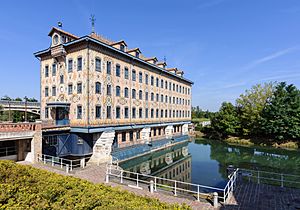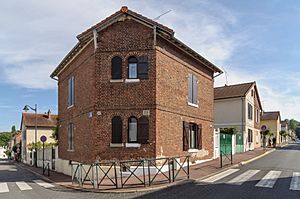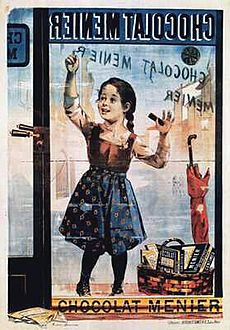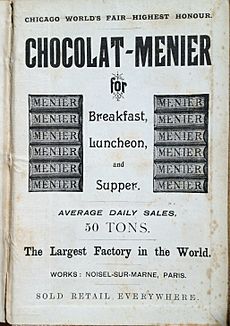Menier Chocolate facts for kids
 |
|
| Private (1816–1971) Subsidiary (1971–) |
|
| Industry | Food |
| Fate | Acquired by Rowntree Mackintosh Confectionery in 1971 |
| Founded | 1816 in Paris |
| Founder | Antoine Brutus Menier |
| Headquarters | , |
|
Area served
|
Worldwide |
| Products | Chocolate bars |
| Owner | Nestlé |
The Menier Chocolate company (French: Chocolat Menier) is a famous French chocolate maker. It started in 1816 in Paris, France. At first, it was a company that made medicines. Chocolate was only a small part of their business back then. It was often used as a medicinal product.
Antoine Brutus Menier founded the company. His family managed it for over 150 years. In 1971, Rowntree Mackintosh Confectionery bought Menier. Later, in 1988, the big Swiss company Nestlé bought Rowntree Mackintosh. This meant Menier became part of Nestlé. In 1996, Menier's chocolate production moved to Broc, Switzerland. The old factory building in Noisiel became Nestlé France's main office.
Contents
The Story of Menier Chocolate
Who Ran Menier Chocolate?
The Menier family controlled the company for more than 150 years. Here are some of the main leaders:
- Antoine Brutus Menier (1795–1853), the founder
- Emile-Justin Menier (1826–81), who became the sole CEO
- Gaston Menier (1855–1934), who was the Chief Operating Officer
- Henri Menier (1853–1913), another CEO
- Hubert Menier (1910–59), who shared the CEO role with Antoine
- Antoine Gilles Menier (1904–67), the last CEO from the family
In 1816, Antoine Brutus Menier started the Menier Hardware Company in Paris. He wasn't a trained pharmacist. But he began making and selling different powders for health reasons. The business grew quickly. For the first few years, they made very little chocolate. It was mainly used as a medicinal powder or to coat bitter pills.
Building the Noisiel Factory
In 1825, the company started to grow. They bought a second production place on the banks of the Marne River in Noisiel. At that time, Noisiel was a tiny village near Paris. It had fewer than 200 people. This new place was first used to grind medicinal powders.
In 1830, the Noisiel facility was updated. It became the first factory in France to use machines to mass-produce cocoa powder. In 1836, Menier created solid chocolate. They sold chocolate bars with six pieces, wrapped in yellow paper. By 1842, their chocolate business was so successful that they expanded the Noisiel plant again. By 1853, they were making 4,000 tons of chocolate each year.
Focusing on Chocolate
Emile-Justin Menier, the founder's son, took over. He decided the company should only make chocolate. In 1864, he sold the part of the business that made medicines. He then started a period of big growth. This made Menier Chocolate the largest chocolate maker in France.
Under Emile-Justin Menier, the company bought cocoa farms in Nicaragua. They also bought sugar beet fields and a sugar refinery in Roye, France. This helped them control their ingredients.
From 1860, Emile-Justin Menier added several new buildings. He built a factory in London and a distribution center in New York City. In 1872, he started a huge expansion. This included building some of the most modern factories in the world. The architect Jules Saulnier designed them. Many people say his 1872 iron and brick chocolate factory at Noisiel was one of the most important buildings of the Industrial Revolution. In 1992, the French government made the factory a Monument historique. It is also being considered as a UNESCO World Heritage Site.
A Company Town for Workers
Because the factory grew so much, by the mid-1880s, the Noisiel plant could make 125,000 tons of chocolate every year. The company employed 2,000 people. Noisiel was a small village, so there weren't enough workers. Menier had to attract people from other towns. But there wasn't enough housing.
So, in 1874, Menier built 312 homes on 30 hectares of land near the factory. They also built a school for their employees' children. Thirty years later, they built a home for their retired workers. In the 1870s, the Meniers also built the Noisiel town hall. A family member served as mayor there for many years.
At the 1878 World's Fair in Paris, Menier won seven gold medals. They also received the Grand Prize for their excellent products. They were praised for their modern production methods and for caring about their employees.
After Emile Justin Menier died in 1881, his sons Henri and Gaston took over. Henri was the older son and the official head of the company. But he spent a lot of time on his hobbies. Gaston managed most of the business. He led the company through a very successful time.
To stay competitive, Menier added modern refrigeration systems. In 1881, a railroad line was built to the Noisiel factory. This helped them save money on shipping and distribute products faster and wider. At the same time, Swiss chocolate makers were creating new products. They started mass-producing milk chocolate. They also used a new process called conching. This made chocolate that melted in your mouth, which people loved.
Smart Advertising Ideas
In 1893, the company started using advertising posters by Firmin Bouisset. These posters showed a little girl writing "Chocolat Menier" on a wall with a piece of chocolate. The sweet, innocent girl helped share the message of sweet chocolate. This image became very famous around the world.
The little girl's image was used on Menier's chocolate packages. It also appeared on promotional items like tin boxes, creamers, bowls, and even children's school books. Original Menier posters and products are still popular today.
Menier also sold small dark chocolate sticks to put inside bread. To get more people to know about their products, they set up "chocolate kiosques" on sidewalks in French towns. These kiosks had a hexagon shape and a peaked roof. They became the standard design for newspaper kiosks. They were so popular that Menier even made plastic model kiosks for children. These toys were filled with tiny chocolate bars.
Menier Chocolate Company showed their products at the 1893 World's Fair in Chicago. They were called the leading chocolate makers in the world. As the business grew, more buildings were added to the Noisiel plant around 1900. One big building was among the first to use reinforced concrete. Locals called it the "Cathedral" because of its look. The company also built Pont Hardi, a 44.5-meter-long concrete bridge. This was a record at the time. It crossed the Marne River to connect the new building to the other factories.
Later Years and Today
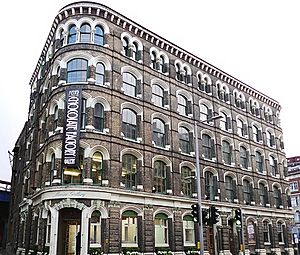
World War I (1914-1918) began the decline of the Menier Chocolate company. While Europe was in chaos, companies in neutral Switzerland and the United States grew quickly. They were not affected by the war. By the end of the war, Menier's money was weaker. Also, there was much more competition and new technologies.
Gaston Menier died in 1934. World War II (1939-1945) made the company's problems even worse. Hubert and Antoine Menier ran the business, but they struggled with the challenges. Even though Menier was well-known and used fables by Jean de La Fontaine in children's books for marketing, by the 1950s, they were losing market share and money to competitors.
In 1957, Menier Chocolate took over the Lombart Chocolate company. Hubert Menier died in 1959. Antoine was the last Menier family member to run the business. By the 1960s, Menier's workforce had dropped to about 250 people. At its peak, it had over 2,000.
In 1960, Menier had to find a buyer. It merged with the Cacao Barry company. By 1965, the Menier family no longer owned any part of the company. The Menier factory was sold to Group Ufico-Perrier. This group became part of British confectioners Rowntree Mackintosh in 1971. Then, in 1988, the Swiss food giant, Nestlé S.A. bought Rowntree Mackintosh.
In the early 1990s, all chocolate production stopped at the Noisiel factory. But in 1996, Nestlé France opened its main office in the factory's main building. Other buildings in the complex are now part of a chocolate museum. Visitors can take tours there. The Menier Chocolate Factory building on Southwark Street in London is now a popular arts center. It has an art gallery, a restaurant, and a theater.
Today, Menier still sells some chocolate products. You can buy them online through their official website: https://www.menier.co.uk/ and other stores.
See also
 In Spanish: Chocolat Menier para niños
In Spanish: Chocolat Menier para niños


